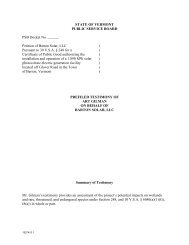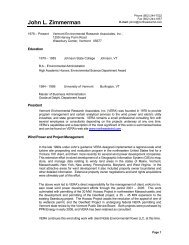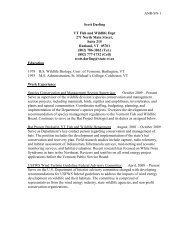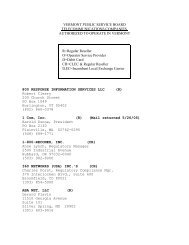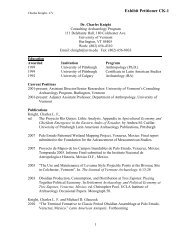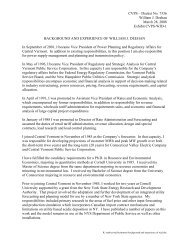Pre-Filed Testimony and Exhibits of David Raphael - Vermont Public ...
Pre-Filed Testimony and Exhibits of David Raphael - Vermont Public ...
Pre-Filed Testimony and Exhibits of David Raphael - Vermont Public ...
Create successful ePaper yourself
Turn your PDF publications into a flip-book with our unique Google optimized e-Paper software.
THE FUTURE USE OF LANb MAP<br />
The Regional P/an’s Future Use <strong>of</strong> L<strong>and</strong> Map is a general guide for<br />
the forthcoming growth <strong>of</strong> the Region. It is based upon analyses from<br />
throughout the P/an <strong>and</strong> attempts to balance competing <strong>and</strong><br />
complementary goals into a single image.<br />
The map is intended to be conceptual: boundaries between area are<br />
imprecise. Specific sites <strong>and</strong> their prescribed uses are addressed<br />
locally.<br />
The map is divided based on preferred densities <strong>of</strong> development<br />
intensity <strong>of</strong> activity. These include four generalized l<strong>and</strong> use areas, a<br />
series <strong>of</strong> labels for the Region’s town centers <strong>and</strong> villages. Together,<br />
these designations promote a cohesive pattern <strong>of</strong> growth <strong>and</strong><br />
conservation that advances the intent <strong>of</strong> the Rut/<strong>and</strong> Regional P/an. 4<br />
Why the Labels <strong>and</strong> L<strong>and</strong> Use Areas Exist<br />
The map is based on an analysis <strong>of</strong> the location, magnitude, <strong>and</strong><br />
potential <strong>of</strong> multiple features that make different areas more or less<br />
suitable, with a goal <strong>of</strong> making efficient use <strong>of</strong> limited infrastructurej<br />
<strong>and</strong> maintaining the unique qualities <strong>of</strong> the Region.<br />
For example, business <strong>and</strong> industry rely on the presence <strong>of</strong> public<br />
water <strong>and</strong> sewer, close proximity <strong>of</strong> major transportation networks,<br />
<strong>and</strong>, in some cases, access to markets for selling their goads.<br />
By the same token, due to physical site limitations (steep slopes <strong>and</strong><br />
wetl<strong>and</strong>s, among others) <strong>and</strong> relatively high costs incidental to l<strong>and</strong><br />
development in certain areas, much <strong>of</strong> the Region is not readily<br />
available for development. These areas are suited for less dense <strong>and</strong><br />
intense development, in keeping with the Regions rural environment.<br />
Additionally, deep, well drained soils, proximity to good roads, <strong>and</strong><br />
access to markets as key elements <strong>of</strong> a successful agricultural future<br />
for the Region. The P/an is also intended to provide for the long-term<br />
sustainability <strong>of</strong> resources, open space <strong>and</strong> scenic l<strong>and</strong>s.<br />
Finally, the P/an seeks to promote housing <strong>and</strong> small business I<br />
development within <strong>and</strong> adjacent to villages that is in keeping with<br />
their unique histories.<br />
The attached map depicts both an efficient use <strong>of</strong> l<strong>and</strong> <strong>and</strong> a<br />
shared vision for the future based on public input. It should be used as<br />
a guide for future development <strong>of</strong> the Region. Planned growth <strong>and</strong><br />
development is directed to those areas most suitable for such<br />
development <strong>and</strong> away from areas in which the proposed growth would<br />
be incompatible, due to the availability <strong>of</strong> services or protection <strong>of</strong><br />
resources.<br />
Using the Map’s Legend<br />
HIGH DENSITY DEVELOPMENT AREAS<br />
Areas shown as “high density” on the map<br />
are those most suitable for large-scale<br />
activity, within <strong>and</strong> in areas contiguous to<br />
the Regions downtowns, sub-regional<br />
centers, <strong>and</strong> industrial centers. They share<br />
a number <strong>of</strong> common features which make<br />
them attractive <strong>and</strong> suitable for these<br />
types <strong>of</strong> activities:<br />
• Ease <strong>of</strong> access to major transportation<br />
routes<br />
• Availability <strong>of</strong> utilities, including public<br />
water <strong>and</strong> sewer <strong>and</strong> high speed<br />
telecommunications<br />
• Historic <strong>and</strong> current areas <strong>of</strong><br />
concentrated population, business, <strong>and</strong><br />
education<br />
• Less critical natural resource <strong>and</strong> wildlife<br />
areas<br />
These areas include the following<br />
designations within the Region:<br />
CENTER- The Regions<br />
economic, population, education,<br />
flURBAN<br />
<strong>and</strong> service focus areas. Businesses<br />
<strong>and</strong> services in this area draw their<br />
employees <strong>and</strong> clients from throughout the<br />
Region. Many <strong>of</strong> the Region’s largest<br />
employers are located in area, making use <strong>of</strong><br />
the conglomeration <strong>of</strong> people <strong>and</strong> services.<br />
SUB-REGIONAL CENTERS-Areas<br />
where central public utilities for<br />
water <strong>and</strong> sewer are available <strong>and</strong><br />
where there exists a central location or<br />
locations for commercial activities, schools,<br />
Why the Map is Blended<br />
<strong>and</strong> civic activities<br />
- I surrounding towns.<br />
for the town <strong>and</strong><br />
Boundaries between the four l<strong>and</strong> use areas are intentionally<br />
blended to underscore the regional nature <strong>of</strong> the map <strong>and</strong> to promote<br />
growth <strong>and</strong> development that is within <strong>and</strong> contiguous to existing<br />
villages, hamlets, town centers, <strong>and</strong> sub-regional centers.<br />
INbUSTRIAL / BUSINESS<br />
PARKS— Areas designated by towns<br />
28 Mopted 415O8 Rutl<strong>and</strong> Regional Plan<br />
I



